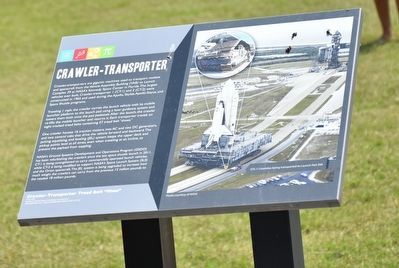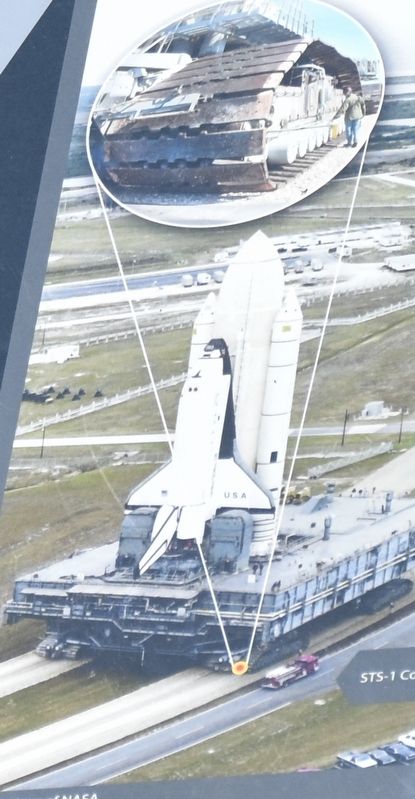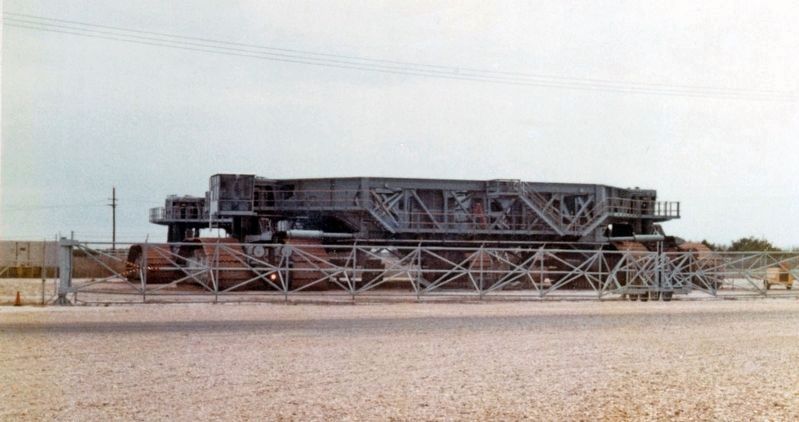Union City in Obion County, Tennessee — The American South (East South Central)
Crawler - Transporter
Crawler-transporters are gigantic machines used to transport rockets and spacecraft from the Vehicle Assembly Building (VAB) to Launch Complex 39 at NASA's Kennedy Space Center in Florida. The largest vehicle ever built, Crawler-transport 1 (CT-1) and 2 (CT-2) were constructed in 1965 and used during the Apollo, Skylab, Apollo-Soyuz, and Space Shuttle programs.
Traveling 1 mph, the crawler carries the launch vehicle with its mobile launcher platform to the launch pad using a laser guidance system and lowers them both onto the pad pedestals. After the launch, the crawler re-lifts the mobile launcher and returns it. Each transporter travels on eight tracked tread belts containing 57 tread belt "shoes."
One crawler houses 16 traction motors, two AC and two DC generators, and two control cabs that drive the vehicle forward and backward. The jacking, equalizing, and leveling (JEL) system keeps the upper deck and pickup points level at all times, even when traveling at an incline, to prevent the payload from toppling.
NASA's Ground System Development and Operations Program (GSDO) has been refurbishing the crawlers since the last space shuttle launch in 2011. CT-1 is being strengthened to carry commercially operated launch vehicles, while CT-2 is being modified to support NASA's Space Launch System (SLS) and the Orion spacecraft. The JEL system is being upgraded to increase how much weight the crawlers can carry from the previous 12 million pounds to the needed 18 million pounds.
Topics. This historical marker is listed in these topic lists: Air & Space • Exploration • Man-Made Features. A significant historical year for this entry is 1965.
Location. 36° 26.21′ N, 89° 4.252′ W. Marker is in Union City, Tennessee, in Obion County. Marker is on Graham Drive. Inside Discover Park America in Exploration area left side park toward the back. Touch for map. Marker is at or near this postal address: 210-260 Graham Dr, Union City TN 38261, United States of America. Touch for directions.
Other nearby markers. At least 8 other markers are within walking distance of this marker. YP-84A Thunderjet (here, next to this marker); Stem Landing (here, next to this marker); F11F-1 Tiger (a few steps from this marker); UH-1B Iroquois (a few steps from this marker); Geodesic Dome (a few steps from this marker); Titan 1 Launch Complex (a few steps from this marker); Engineering the Dome (a few steps from this marker); LR91-AJ -3 Engine (within shouting distance of this marker). Touch for a list and map of all markers in Union City.
Also see . . . NASA's Giant Crawlers turn 50 Years Old, Pivot Future Exploration. Lake County News website entry:
NASA's crawler-transporters, two of the largest vehicles ever built, have carried NASA rockets and spacecraft to the launch pad for the last 50 years. They will continue their legacy as the "workhorses" of the nation's space program as part of the agency's journey to Mars. (Submitted on July 24, 2017, by Sandra Hughes Tidwell of Killen, Alabama, USA.)
Credits. This page was last revised on December 29, 2023. It was originally submitted on July 24, 2017, by Sandra Hughes Tidwell of Killen, Alabama, USA. This page has been viewed 338 times since then and 11 times this year. Photos: 1, 2. submitted on July 24, 2017, by Sandra Hughes Tidwell of Killen, Alabama, USA. 3. submitted on May 27, 2018, by David Graff of Halifax, Nova Scotia. • Bill Pfingsten was the editor who published this page.


